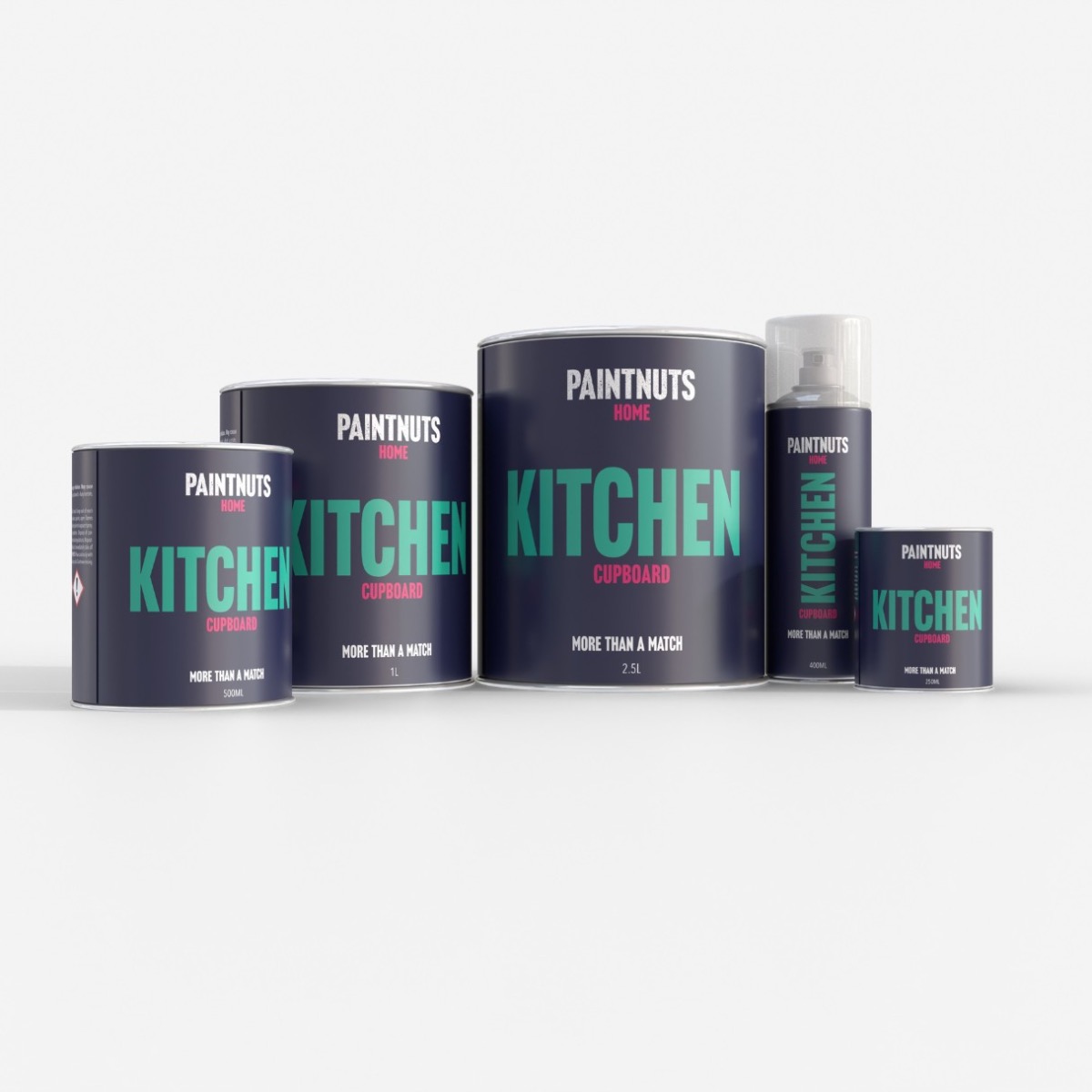This area includes a range of instructional guides.
uPVC Window & Door Paint
Directions When Using Paint Brush / Roller on uPVC Surfaces
1. SURFACE PREPARATION
Begin by using a clean cloth soaked in hot soapy water to effectively eliminate any dust or dirt from the surface. Once the surface is dry, utilise PaintNuts Degreaser to effectively remove stubborn contaminants, grease, or wax that may be present. For improved adhesion and a longer-lasting finish, gently rub the surface with a light grit scotch cloth to remove the sheen and create a better surface for paint adhesion. To ensure a residue-free surface, wipe down the UPVC surface once again with degreaser and allow it to dry completely. After the surface is dry, proceed to mask around the UPVC area using masking tape and paper, preparing it for painting. Before applying the paint, ensure to mix it thoroughly for a minimum of 2 minutes to achieve consistent colour throughout.
2. APPLICATION
Apply the paint using smooth strokes with a brush. Allow the first coat to dry for 15 minutes before proceeding with a second coat if necessary. Once the painting is completed, wait for 15 minutes before carefully removing the masking tape. Make sure to remove the tape by pulling it away from the painted edge, rather than across it, to avoid any damage. Leave the painted surface to dry for 1-2 hours before touching the frame, and ensure a waiting period of 72 hours before attempting to clean the windows. This allows sufficient time for the paint to fully dry and cure.
3. WEATHER CONDITIONS FOR PAINTING:
Weather conditions affect paint application and can impact adhesion and finish. The ideal air temperature is between 10°C and 25°C. It needs to be dry, not damp, with a maximum of 80% humidity and no risk of rain during the application or drying period.
Painting in extreme temperatures (either too cold or too hot) can cause paint to dry too quickly or too slowly, affecting the adhesion and finish. Windy conditions will also adversely affect drying times and can lead to paint contamination. The temperature of the substrate / material you are painting also needs to be considered - it must be a minimum of 5°C but not too hot. If the exterior material (e.g. doors / window frame) feel hot to touch this could affect application, adhesion and finish. It is advisable to apply paint out of direct sunlight - for example painting in mornings is advisable in summer rather than midday heat.
4. STORAGE:
To ensure the paint maintains its performance and lasts longer, it is recommended to store it indoors in a cool and dry area, away from direct sunlight. The ideal storage temperature ranges between 5°C and 25°C. Extreme temperatures can have detrimental effects on the paint's life and overall performance. To preserve the paint's quality, it is best to store it in cupboards inside the house, as garages and sheds can become too cold during winter, while loft spaces can become excessively hot during summer. Both temperature extremes can compromise the paint's quality.
5. CLEANING
Begin by removing as much paint as you can from the brush or roller. Submerge the brush or roller in an appropriate solvent, such as white spirit, paint thinners, or a specialised brush cleaner. Allow the brush or roller to soak in the solvent for approximately 10 to 20 seconds to help loosen the paint. After soaking, wash the brush or roller in warm, soapy water. Rinse off the brush or roller thoroughly, and then dry it using a paper towel.
Directions When Using Spray Cans / Aerosols on uPVC Surfaces
1. SURFACE PREPARATION
Begin by using a clean cloth soaked in hot soapy water to effectively eliminate any dust or dirt from the surface. Once the surface is dry, utilise PaintNuts Degreaser to effectively remove stubborn contaminants, grease, or wax that may be present. For improved adhesion and a longer-lasting finish, gently rub the surface with a light grit scotch cloth to remove the sheen and create a better surface for paint adhesion. To ensure a residue-free surface, wipe down the UPVC surface once again with degreaser and allow it to dry completely. After the surface is dry, proceed to mask around the UPVC area using masking tape and paper, preparing it for painting. Before using the aerosol paint, shake it vigorously for at least 2-3 minutes until the agitator ball is free to ensure consistent colour dispersion.
2. APPLICATION
Hold the aerosol can upright and spray the paint onto the surface and apply in smooth cross coats 250mm distance from the surface, either vertically or horizontally. Keep a consistent distance between the can and the surface to ensure uniform coverage. Allow the first coat to dry for 15 minutes. If additional coats are required, wait for the recommended drying time between each coat, as specified on the aerosol paint can. After completing the painting process, wait for 15 minutes before carefully removing the masking tape. Remove the tape by pulling it away from the painted edge to avoid any damage. Leave the painted surface to dry for 1-2 hours before handling. For optimal curing and durability, allow a waiting period of 72 hours before attempting to clean the surface.
3. WEATHER CONDITIONS FOR PAINTING:
Weather conditions affect paint application and can impact adhesion and finish. The ideal air temperature is between 10°C and 25°C. It needs to be dry, not damp, with a maximum of 80% humidity and no risk of rain during the application or drying period.
Painting in extreme temperatures (either too cold or too hot) can cause paint to dry too quickly or too slowly, affecting the adhesion and finish. Windy conditions will also adversely affect drying times and can lead to paint contamination. The temperature of the substrate / material you are painting also needs to be considered - it must be a minimum of 5°C but not too hot. If the exterior material (e.g. doors / window frame) feel hot to touch this could affect application, adhesion and finish. It is advisable to apply paint out of direct sunlight - for example painting in mornings is advisable in summer rather than midday heat.
4. STORAGE:
To ensure the paint maintains its performance and lasts longer, it is recommended to store it indoors in a cool and dry area, away from direct sunlight. The ideal storage temperature ranges between 5°C and 25°C. Extreme temperatures can have detrimental effects on the paint's life and overall performance. To preserve the paint's quality, it is best to store it in cupboards inside the house, as garages and sheds can become too cold during winter, while loft spaces can become excessively hot during summer. Both temperature extremes can compromise the paint's quality.
5. CLEANING
After use turn the can upside down and spray until the valve is clean, preventing the valve from clogging up. Remove as much paint as possible from the aerosol nozzle or any other reusable parts. Submerge the nozzle or reusable parts in an appropriate solvent, such as white spirit, paint thinners, or a specialised brush cleaner. Allow them to soak in the solvent for approximately 10 to 20 seconds to help loosen the paint. After soaking, wash the nozzle or reusable parts in warm, soapy water. Rinse off the nozzle or reusable parts thoroughly, ensuring all paint and soap residues are removed, and then dry them using a paper towel.
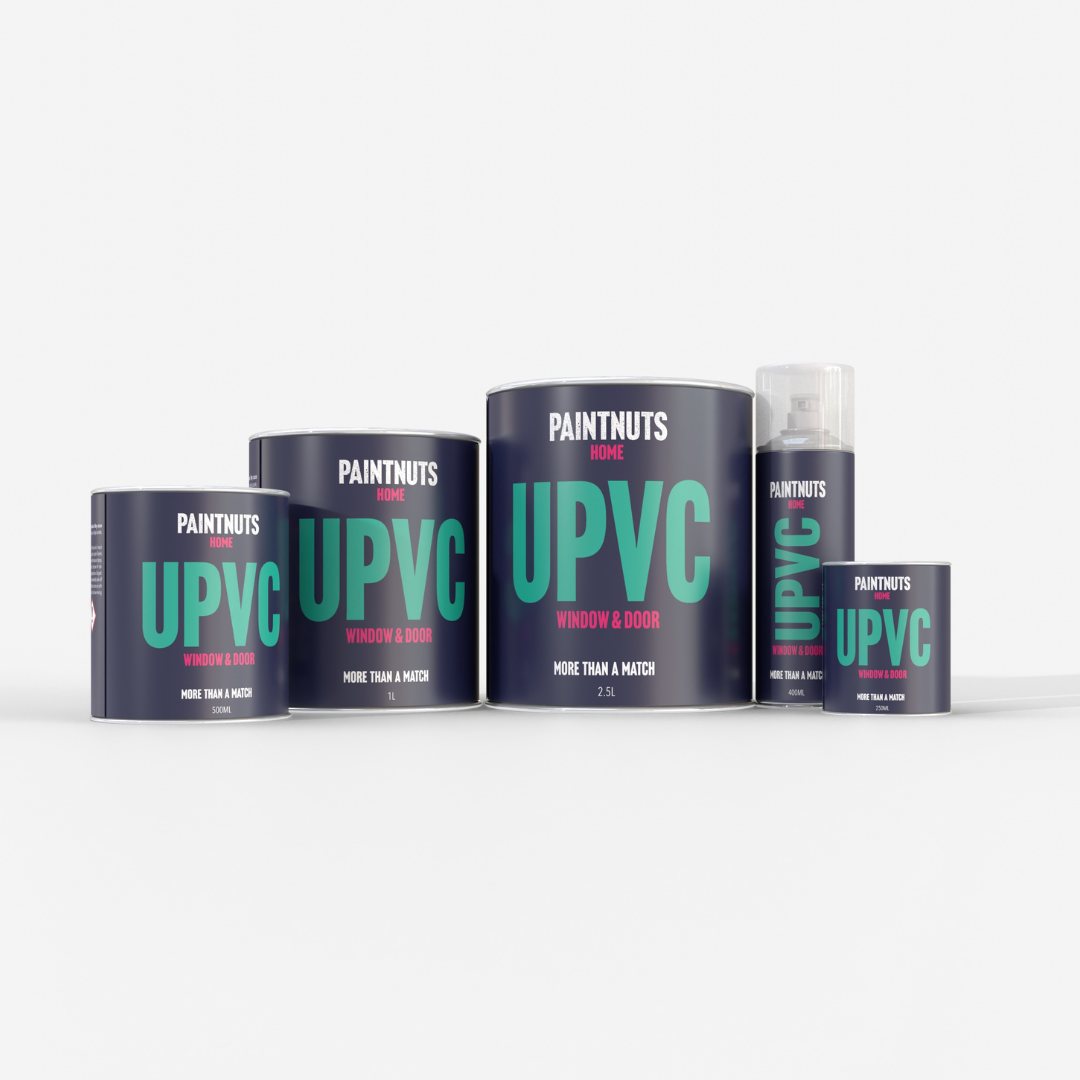
Wood Window & Door Paint
Directions When Using Paint Brush / Roller on Wooden Surfaces
1. SURFACE PREPARATION:
Begin by using a clean cloth soaked in hot soapy water to effectively eliminate any dust or dirt from the surface. Once the surface is dry, utilise PaintNuts Degreaser to effectively remove stubborn contaminants, grease, or wax that may be present. For improved adhesion and a longer-lasting finish, gently rub the surface with a light grit scotch cloth to remove the sheen and create a better surface for paint adhesion. To ensure a residue-free surface, wipe down the Wooden surface once again with degreaser and allow it to dry completely. After the surface is dry, proceed to mask around the Wooden area using masking tape and paper, preparing it for painting. Before applying the paint, ensure to mix it thoroughly for a minimum of 2 minutes to achieve consistent colour throughout.
2. APPLICATION:
Apply the paint using smooth strokes with a brush. Allow the first coat to dry for 15 minutes before proceeding with a second coat if necessary. Once the painting is completed, wait for 15 minutes before carefully removing the masking tape. Make sure to remove the tape by pulling it away from the painted edge, rather than across it, to avoid any damage. Leave the painted surface to dry for 1-2 hours before touching the frame, and ensure a waiting period of 72 hours before attempting to clean the surface. This allows sufficient time for the paint to fully dry and cure.
3. WEATHER CONDITIONS FOR PAINTING:
Weather conditions affect paint application and can impact adhesion and finish. The ideal air temperature is between 10°C and 25°C. It needs to be dry, not damp, with a maximum of 80% humidity and no risk of rain during the application or drying period.
Painting in extreme temperatures (either too cold or too hot) can cause paint to dry too quickly or too slowly, affecting the adhesion and finish. Windy conditions will also adversely affect drying times and can lead to paint contamination. The temperature of the substrate / material you are painting also needs to be considered - it must be a minimum of 5°C but not too hot. If the exterior material (e.g. doors / window frame) feel hot to touch this could affect application, adhesion and finish. It is advisable to apply paint out of direct sunlight - for example painting in mornings is advisable in summer rather than midday heat.
4. STORAGE:
To ensure the paint maintains its performance and lasts longer, it is recommended to store it indoors in a cool and dry area, away from direct sunlight. The ideal storage temperature ranges between 5°C and 25°C. Extreme temperatures can have detrimental effects on the paint's life and overall performance. To preserve the paint's quality, it is best to store it in cupboards inside the house, as garages and sheds can become too cold during winter, while loft spaces can become excessively hot during summer. Both temperature extremes can compromise the paint's quality.
5. CLEANING:
Begin by removing as much paint as you can from the brush or roller. Submerge the brush or roller in an appropriate solvent, such as white spirit, paint thinners, or a specialised brush cleaner. Allow the brush or roller to soak in the solvent for approximately 10 to 20 seconds to help loosen the paint. After soaking, wash the brush or roller in warm, soapy water. Rinse off the brush or roller thoroughly, and then dry it using a paper towel.
Directions When Using Spray Cans / Aerosols on Wooden Surfaces
1. SURFACE PREPARATION:
Begin by using a clean cloth soaked in hot soapy water to effectively eliminate any dust or dirt from the surface. Once the surface is dry, utilise PaintNuts Degreaser to effectively remove stubborn contaminants, grease, or wax that may be present. For improved adhesion and a longer-lasting finish, gently rub the surface with a light grit scotch cloth to remove the sheen and create a better surface for paint adhesion. To ensure a residue-free surface, wipe down the Wooden surface once again with degreaser and allow it to dry completely. After the surface is dry, proceed to mask around the Wooden area using masking tape and paper, preparing it for painting. Before using the aerosol paint, shake it vigorously for at least 2-3 minutes until the agitator ball is free to ensure consistent colour dispersion.
2. APPLICATION:
Hold the aerosol can upright and spray the paint onto the surface and apply in smooth cross coats 250mm distance from the surface, either vertically or horizontally. Keep a consistent distance between the can and the surface to ensure uniform coverage. Allow the first coat to dry for 15 minutes. If additional coats are required, wait for the recommended drying time between each coat, as specified on the aerosol paint can. After completing the painting process, wait for 15 minutes before carefully removing the masking tape. Remove the tape by pulling it away from the painted edge to avoid any damage. Leave the painted surface to dry for 1-2 hours before handling. For optimal curing and durability, allow a waiting period of 72 hours before attempting to clean the surface.
3. WEATHER CONDITIONS FOR PAINTING:
Weather conditions affect paint application and can impact adhesion and finish. The ideal air temperature is between 10°C and 25°C. It needs to be dry, not damp, with a maximum of 80% humidity and no risk of rain during the application or drying period.
Painting in extreme temperatures (either too cold or too hot) can cause paint to dry too quickly or too slowly, affecting the adhesion and finish. Windy conditions will also adversely affect drying times and can lead to paint contamination. The temperature of the substrate / material you are painting also needs to be considered - it must be a minimum of 5°C but not too hot. If the exterior material (e.g. doors / window frame) feel hot to touch this could affect application, adhesion and finish. It is advisable to apply paint out of direct sunlight - for example painting in mornings is advisable in summer rather than midday heat.
4. STORAGE:
To ensure the paint maintains its performance and lasts longer, it is recommended to store it indoors in a cool and dry area, away from direct sunlight. The ideal storage temperature ranges between 5°C and 25°C. Extreme temperatures can have detrimental effects on the paint's life and overall performance. To preserve the paint's quality, it is best to store it in cupboards inside the house, as garages and sheds can become too cold during winter, while loft spaces can become excessively hot during summer. Both temperature extremes can compromise the paint's quality.
5. CLEANING:
After use turn the can upside down and spray until the valve is clean, preventing the valve from clogging up. Remove as much paint as possible from the aerosol nozzle or any other reusable parts. Submerge the nozzle or reusable parts in an appropriate solvent, such as white spirit, paint thinners, or a specialised brush cleaner. Allow them to soak in the solvent for approximately 10 to 20 seconds to help loosen the paint. After soaking, wash the nozzle or reusable parts in warm, soapy water. Rinse off the nozzle or reusable parts thoroughly, ensuring all paint and soap residues are removed, and then dry them using a paper towel.
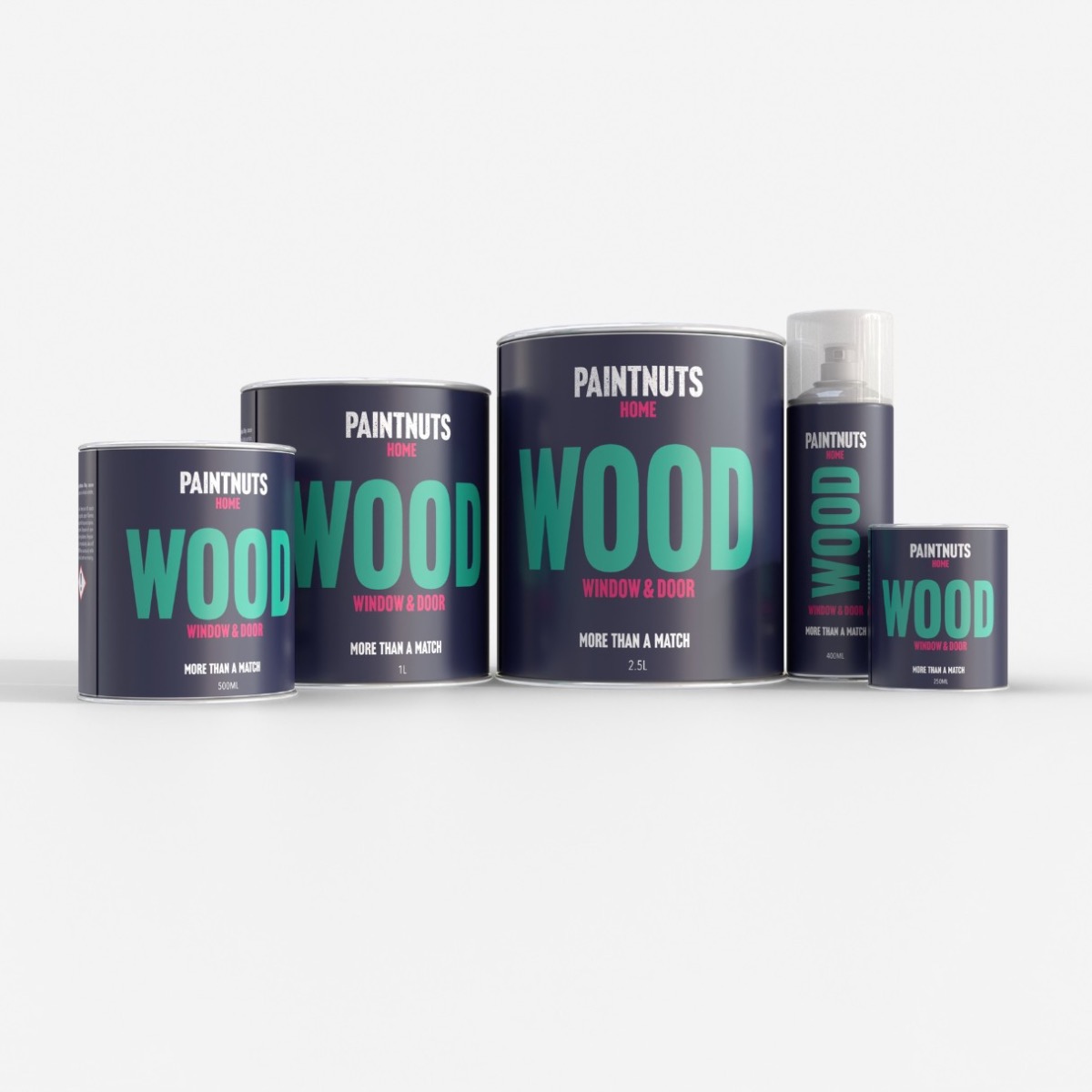
Aluminium Window & Door Paint
Directions When Using Paint Brush / Roller on Aluminium Surfaces
1. SURFACE PREPARATION:
Begin by using a clean cloth soaked in hot soapy water to effectively eliminate any dust or dirt from the surface. Once the surface is dry, utilise PaintNuts Degreaser to effectively remove stubborn contaminants, grease, or wax that may be present. For improved adhesion and a longer-lasting finish, gently rub the surface with a light grit scotch cloth to remove the sheen and create a better surface for paint adhesion. To ensure a residue-free surface, wipe down the Aluminium surface once again with degreaser and allow it to dry completely. After the surface is dry, proceed to mask around the Aluminium area using masking tape and paper, preparing it for painting. Before applying the paint, ensure to mix it thoroughly for a minimum of 2 minutes to achieve consistent colour throughout.
2. APPLICATION:
Apply the paint using smooth strokes with a brush. Allow the first coat to dry for 15 minutes before proceeding with a second coat if necessary. Once the painting is completed, wait for 15 minutes before carefully removing the masking tape. Make sure to remove the tape by pulling it away from the painted edge, rather than across it, to avoid any damage. Leave the painted surface to dry for 1-2 hours before touching the frame, and ensure a waiting period of 72 hours before attempting to clean the surface. This allows sufficient time for the paint to fully dry and cure.
3. WEATHER CONDITIONS FOR PAINTING:
Weather conditions affect paint application and can impact adhesion and finish. The ideal air temperature is between 10°C and 25°C. It needs to be dry, not damp, with a maximum of 80% humidity and no risk of rain during the application or drying period.
Painting in extreme temperatures (either too cold or too hot) can cause paint to dry too quickly or too slowly, affecting the adhesion and finish. Windy conditions will also adversely affect drying times and can lead to paint contamination. The temperature of the substrate / material you are painting also needs to be considered - it must be a minimum of 5°C but not too hot. If the exterior material (e.g. doors / window frame) feel hot to touch this could affect application, adhesion and finish. It is advisable to apply paint out of direct sunlight - for example painting in mornings is advisable in summer rather than midday heat.
4. STORAGE:
To ensure the paint maintains its performance and lasts longer, it is recommended to store it indoors in a cool and dry area, away from direct sunlight. The ideal storage temperature ranges between 5°C and 25°C. Extreme temperatures can have detrimental effects on the paint's life and overall performance. To preserve the paint's quality, it is best to store it in cupboards inside the house, as garages and sheds can become too cold during winter, while loft spaces can become excessively hot during summer. Both temperature extremes can compromise the paint's quality.
5. CLEANING:
Begin by removing as much paint as you can from the brush or roller. Submerge the brush or roller in an appropriate solvent, such as white spirit, paint thinners, or a specialised brush cleaner. Allow the brush or roller to soak in the solvent for approximately 10 to 20 seconds to help loosen the paint. After soaking, wash the brush or roller in warm, soapy water. Rinse off the brush or roller thoroughly, and then dry it using a paper towel.
Directions When Using Spray Cans / Aerosols on Aluminium Surfaces
1. SURFACE PREPARATION:
Begin by using a clean cloth soaked in hot soapy water to effectively eliminate any dust or dirt from the surface. Once the surface is dry, utilise PaintNuts Degreaser to effectively remove stubborn contaminants, grease, or wax that may be present. For improved adhesion and a longer-lasting finish, gently rub the surface with a light grit scotch cloth to remove the sheen and create a better surface for paint adhesion. To ensure a residue-free surface, wipe down the Aluminium surface once again with degreaser and allow it to dry completely. After the surface is dry, proceed to mask around the Aluminium area using masking tape and paper, preparing it for painting. Before using the aerosol paint, shake it vigorously for at least 2-3 minutes until the agitator ball is free to ensure consistent colour dispersion.
2. APPLICATION:
Hold the aerosol can upright and spray the paint onto the surface and apply in smooth cross coats 250mm distance from the surface, either vertically or horizontally. Keep a consistent distance between the can and the surface to ensure uniform coverage. Allow the first coat to dry for 15 minutes. If additional coats are required, wait for the recommended drying time between each coat, as specified on the aerosol paint can. After completing the painting process, wait for 15 minutes before carefully removing the masking tape. Remove the tape by pulling it away from the painted edge to avoid any damage. Leave the painted surface to dry for 1-2 hours before handling. For optimal curing and durability, allow a waiting period of 72 hours before attempting to clean the surface.
3. WEATHER CONDITIONS FOR PAINTING:
Weather conditions affect paint application and can impact adhesion and finish. The ideal air temperature is between 10°C and 25°C. It needs to be dry, not damp, with a maximum of 80% humidity and no risk of rain during the application or drying period.
Painting in extreme temperatures (either too cold or too hot) can cause paint to dry too quickly or too slowly, affecting the adhesion and finish. Windy conditions will also adversely affect drying times and can lead to paint contamination. The temperature of the substrate / material you are painting also needs to be considered - it must be a minimum of 5°C but not too hot. If the exterior material (e.g. doors / window frame) feel hot to touch this could affect application, adhesion and finish. It is advisable to apply paint out of direct sunlight - for example painting in mornings is advisable in summer rather than midday heat.
4. STORAGE:
To ensure the paint maintains its performance and lasts longer, it is recommended to store it indoors in a cool and dry area, away from direct sunlight. The ideal storage temperature ranges between 5°C and 25°C. Extreme temperatures can have detrimental effects on the paint's life and overall performance. To preserve the paint's quality, it is best to store it in cupboards inside the house, as garages and sheds can become too cold during winter, while loft spaces can become excessively hot during summer. Both temperature extremes can compromise the paint's quality.
5. CLEANING:
After use turn the can upside down and spray until the valve is clean, preventing the valve from clogging up. Remove as much paint as possible from the aerosol nozzle or any other reusable parts. Submerge the nozzle or reusable parts in an appropriate solvent, such as white spirit, paint thinners, or a specialised brush cleaner. Allow them to soak in the solvent for approximately 10 to 20 seconds to help loosen the paint. After soaking, wash the nozzle or reusable parts in warm, soapy water. Rinse off the nozzle or reusable parts thoroughly, ensuring all paint and soap residues are removed, and then dry them using a paper towel.
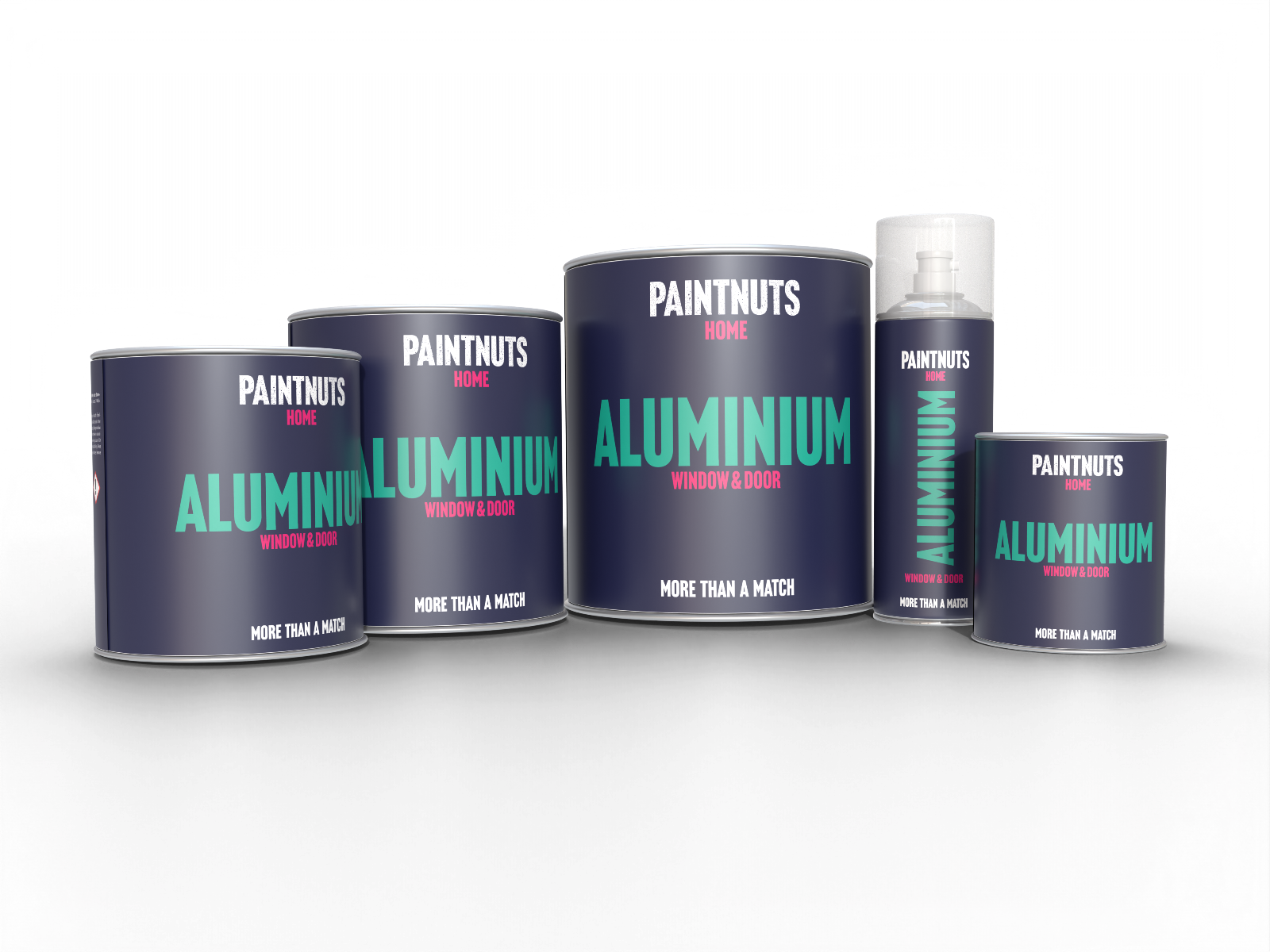
Garden Furniture Paint
Directions When Using Paint Brush / Roller on Garden Furniture
1. SURFACE PREPARATION:
Begin by using a clean cloth soaked in hot soapy water to effectively eliminate any dust or dirt from the surface. Once the surface is dry, utilise PaintNuts Degreaser to effectively remove stubborn contaminants, grease, or wax that may be present. For improved adhesion and a longer-lasting finish, gently rub the surface with a light grit scotch cloth to remove the sheen and create a better surface for paint adhesion. To ensure a residue-free surface, wipe down the Garden Furniture surface once again with degreaser and allow it to dry completely. After the surface is dry, proceed to mask around the Garden Furniture area using masking tape and paper, preparing it for painting. Before applying the paint, ensure to mix it thoroughly for a minimum of 2 minutes to achieve consistent colour throughout.
2. APPLICATION:
Apply the paint using smooth strokes with a brush. Allow the first coat to dry for 15 minutes before proceeding with a second coat if necessary. Once the painting is completed, wait for 15 minutes before carefully removing the masking tape. Make sure to remove the tape by pulling it away from the painted edge, rather than across it, to avoid any damage. Leave the painted surface to dry for 1-2 hours before touching the frame, and ensure a waiting period of 72 hours before attempting to clean the surface. This allows sufficient time for the paint to fully dry and cure.
3. WEATHER CONDITIONS FOR PAINTING:
Weather conditions affect paint application and can impact adhesion and finish. The ideal air temperature is between 10°C and 25°C. It needs to be dry, not damp, with a maximum of 80% humidity and no risk of rain during the application or drying period.
Painting in extreme temperatures (either too cold or too hot) can cause paint to dry too quickly or too slowly, affecting the adhesion and finish. Windy conditions will also adversely affect drying times and can lead to paint contamination. The temperature of the substrate / material you are painting also needs to be considered - it must be a minimum of 5°C but not too hot. If the exterior material (e.g. doors / window frame) feel hot to touch this could affect application, adhesion and finish. It is advisable to apply paint out of direct sunlight - for example painting in mornings is advisable in summer rather than midday heat.
4. STORAGE:
To ensure the paint maintains its performance and lasts longer, it is recommended to store it indoors in a cool and dry area, away from direct sunlight. The ideal storage temperature ranges between 5°C and 25°C. Extreme temperatures can have detrimental effects on the paint's life and overall performance. To preserve the paint's quality, it is best to store it in cupboards inside the house, as garages and sheds can become too cold during winter, while loft spaces can become excessively hot during summer. Both temperature extremes can compromise the paint's quality.
5. CLEANING:
Begin by removing as much paint as you can from the brush or roller. Submerge the brush or roller in an appropriate solvent, such as white spirit, paint thinners, or a specialised brush cleaner. Allow the brush or roller to soak in the solvent for approximately 10 to 20 seconds to help loosen the paint. After soaking, wash the brush or roller in warm, soapy water. Rinse off the brush or roller thoroughly, and then dry it using a paper towel.
Directions When Using Spray Cans / Aerosols on Garden Furniture
1. SURFACE PREPARATION:
Begin by using a clean cloth soaked in hot soapy water to effectively eliminate any dust or dirt from the surface. Once the surface is dry, utilise PaintNuts Degreaser to effectively remove stubborn contaminants, grease, or wax that may be present. For improved adhesion and a longer-lasting finish, gently rub the surface with a light grit scotch cloth to remove the sheen and create a better surface for paint adhesion. To ensure a residue-free surface, wipe down the Garden Furniture surface once again with degreaser and allow it to dry completely. After the surface is dry, proceed to mask around the Garden Furniture area using masking tape and paper, preparing it for painting. Before using the aerosol paint, shake it vigorously for at least 2-3 minutes until the agitator ball is free to ensure consistent colour dispersion.
2. APPLICATION:
Hold the aerosol can upright and spray the paint onto the surface and apply in smooth cross coats 250mm distance from the surface, either vertically or horizontally. Keep a consistent distance between the can and the surface to ensure uniform coverage. Allow the first coat to dry for 15 minutes. If additional coats are required, wait for the recommended drying time between each coat, as specified on the aerosol paint can. After completing the painting process, wait for 15 minutes before carefully removing the masking tape. Remove the tape by pulling it away from the painted edge to avoid any damage. Leave the painted surface to dry for 1-2 hours before handling. For optimal curing and durability, allow a waiting period of 72 hours before attempting to clean the surface.
3. WEATHER CONDITIONS FOR PAINTING:
Weather conditions affect paint application and can impact adhesion and finish. The ideal air temperature is between 10°C and 25°C. It needs to be dry, not damp, with a maximum of 80% humidity and no risk of rain during the application or drying period.
Painting in extreme temperatures (either too cold or too hot) can cause paint to dry too quickly or too slowly, affecting the adhesion and finish. Windy conditions will also adversely affect drying times and can lead to paint contamination. The temperature of the substrate / material you are painting also needs to be considered - it must be a minimum of 5°C but not too hot. If the exterior material (e.g. doors / window frame) feel hot to touch this could affect application, adhesion and finish. It is advisable to apply paint out of direct sunlight - for example painting in mornings is advisable in summer rather than midday heat.
4. STORAGE:
To ensure the paint maintains its performance and lasts longer, it is recommended to store it indoors in a cool and dry area, away from direct sunlight. The ideal storage temperature ranges between 5°C and 25°C. Extreme temperatures can have detrimental effects on the paint's life and overall performance. To preserve the paint's quality, it is best to store it in cupboards inside the house, as garages and sheds can become too cold during winter, while loft spaces can become excessively hot during summer. Both temperature extremes can compromise the paint's quality.
5. CLEANING:
After use turn the can upside down and spray until the valve is clean, preventing the valve from clogging up. Remove as much paint as possible from the aerosol nozzle or any other reusable parts. Submerge the nozzle or reusable parts in an appropriate solvent, such as white spirit, paint thinners, or a specialised brush cleaner. Allow them to soak in the solvent for approximately 10 to 20 seconds to help loosen the paint. After soaking, wash the nozzle or reusable parts in warm, soapy water. Rinse off the nozzle or reusable parts thoroughly, ensuring all paint and soap residues are removed, and then dry them using a paper towel.
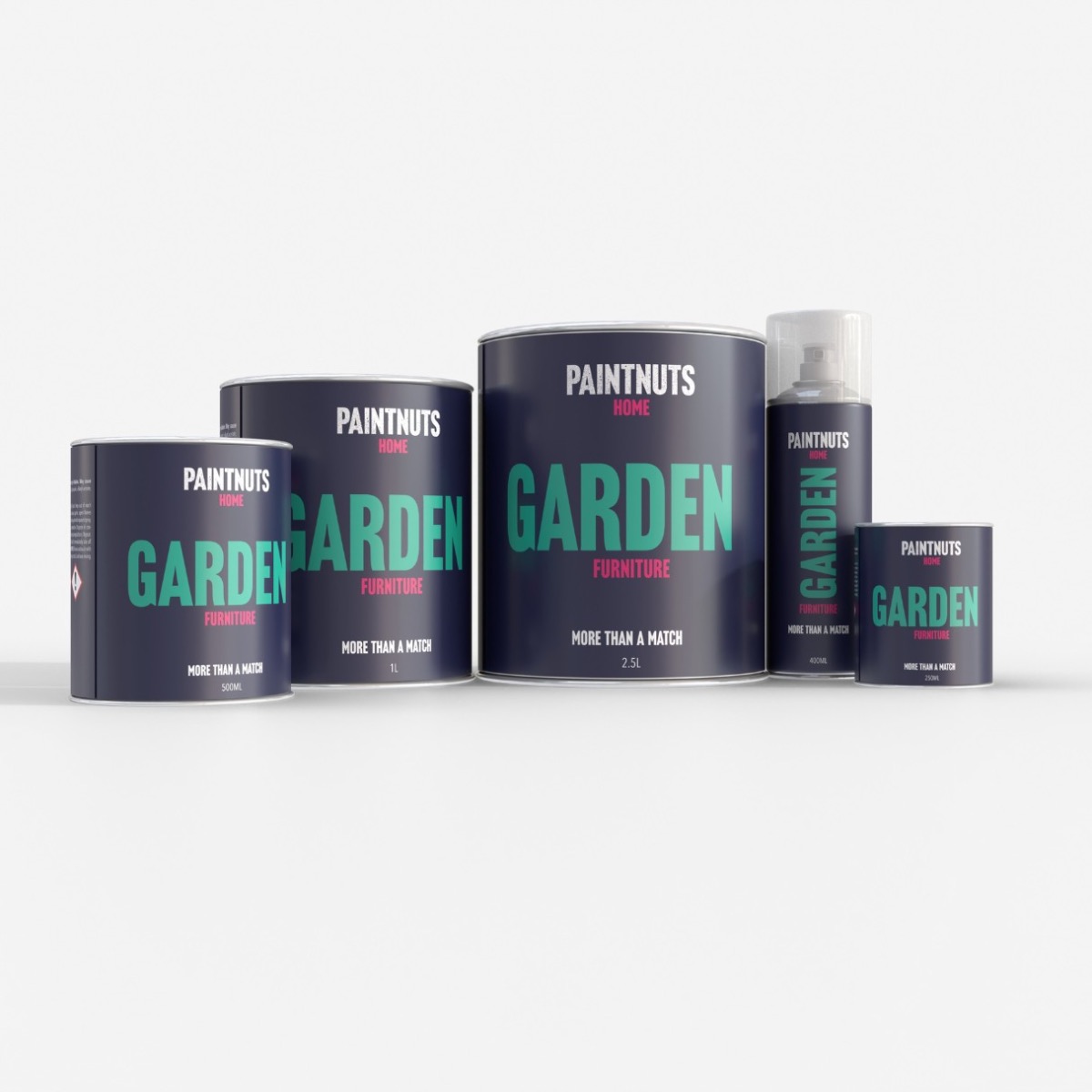
Kitchen Cupboard Paint
Directions When Using Paint Brush / Roller on Kitchen Cupboards
1. SURFACE PREPARATION
Use a clean cloth with hot soapy water to remove any dust or dirt on the surface. Once dry use PaintNuts Degreaser to remove any stubborn contaminants, grease or wax. Use a light grit scotch cloth to 'key' the surface to take off the sheen and improve adhesion for a longer lasting finish. Wipe down the surface with degreaser again to remove any residue and leave to dry. Once dry, if required, mask around the surface area with masking tape and paper ready for painting. Mix paint for at least 2 minutes prior to application to ensure colour consistency.
2. APPLICATION
Brush on in smooth strokes. Leave to dry for one hour before applying a second coat. Once you’ve finished painting wait 15 minutes then carefully remove the masking tape, ensuring you pull the tape away from the painted edge not across it. Leave to dry for at least one hour before touching and 24 hours before cleaning.
PLEASE NOTE: If painting outdoors paint should not be applied in cold, damp weather – it will adversely affect the application, finish, and drying time. The recommended minimum temperature for painting is between 10°C and 25°C, preferably out of direct sunlight.
3. CLEANING & STORAGE
Remove as much paint as possible and clean equipment with warm water. Store indoors in a cool, dry location between 5°C and 25°C and out of direct sunlight. Use within 12 months once opened.
Directions When Using Spray Cans / Aerosols on Kitchen Cupboards
1. SURFACE PREPARATION
Use a clean cloth with hot soapy water to remove any dust or dirt on the surface. Once dry use PaintNuts Degreaser to remove any stubborn contaminants, grease or wax. Use a light grit scotch cloth to 'key' the surface to take off the sheen and improve adhesion for a longer lasting finish. Wipe down the surface with degreaser again to remove any residue and leave to dry. Once dry, if required, mask around the surface area with masking tape and paper ready for painting. Shake the spray can vigorously for 2-3 minutes until the agitator ball is free and the paint is thoroughly mixed. Before applying the paint, we recommend testing the colour and adjusting the spray nozzle for either horizontal or vertical painting.
2. APPLICATION
Apply in smooth cross coats 250mm distance from the surface, either vertically or horizontally Leave to dry for one hour before applying a recommended second coat. Once you’ve finished painting wait 15 minutes then carefully remove the masking tape, ensuring you pull the tape away from the painted edge not across it. Leave to dry for at least one hour before touching and 24 hours before cleaning.
PLEASE NOTE: If painting outdoors paint should not be applied in cold, damp weather – it will adversely affect the application, finish, and drying time. The recommended minimum temperature for painting is between 10°C and 25°C, preferably out of direct sunlight.
3. CLEANING & STORAGE
After use turn the aerosol upside down and press to empty nozzle and valve, wipe the nozzle with a cloth to remove any excess paint, it can be reused at a later date. Remove as much paint as possible and clean equipment with warm water. Store indoors in a cool, dry location between 5°C and 25°C and out of direct sunlight. Use within 12 months once opened.
